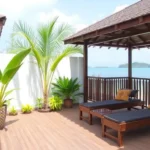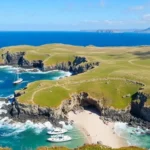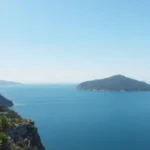Guide to Visiting the Cíes Islands
Imagine a destination that feels like an untouched paradise, where the sound of the waves harmonizes with the songs of seabirds, and the sunsets paint the sky in hues of orange, pink, and purple. Welcome to the Cíes Islands, a hidden treasure of Galicia, Spain. If you're planning to explore this stunning archipelago, our comprehensive travel guide to the Cíes Islands is your essential companion, brimming with insights and tips to make the most of your visit.
1. Discovering the Cíes Islands
The Cíes Islands, part of the Atlantic Islands of Galicia National Park, consist of three main isles: Northern Island (Monteagudo), Middle Island (Faro), and Southern Island (San Martiño). For practical purposes, most visitors will explore the Northern and Middle Islands, connected by a bridge, as the Southern Island is only reachable via private boat.
Exploring the Cíes is a walking affair; there are no vehicles or cruise-style boats taking you around. Instead, you’ll traverse the breathtaking landscapes on foot, embracing the serenity and natural beauty surrounding you.
This unspoiled paradise, along with the island of Ons and several smaller uninhabited isles, forms a protected ecosystem designed to shield its environment from mass tourism. Expect no bustling roads or towering hotels; the only accommodation available is a solitary camping site that offers a unique way to immerse yourself in nature. For those looking for Cíes Islands accommodation, the campsite provides an authentic experience amidst stunning landscapes.
The fame of the Cíes Islands skyrocketed thanks to Rod's Beach, hailed as one of the most beautiful beaches in the world. However, the Cíes offer much more than just stunning sandy shores. With trekking paths that unveil awe-inspiring vistas, colonies of seabirds for birdwatching enthusiasts, and a designation as a starlight destination, the islands promise an unforgettable experience.
Staying overnight in this paradise, even without the luxuries of a hotel, is indeed a privilege. Just remember to pack your sleeping bag for those breezy nights!
2. Getting to the Cíes Islands
Accessing the Cíes Islands is a breeze; simply hop on a ferry. Several companies operate routes from various points along the Galician coast to the Northern Island's port. The journey typically lasts around 45 minutes, with tickets priced at approximately €18.50 to €19.50 for a round trip.
For detailed information on how to reach the Cíes Islands, check out our comprehensive guide.
Requesting the Permit
Whether you're visiting for the day or planning to stay overnight at the campsite, securing a permit from the Xunta de Galicia is essential. Daily access is limited to 2,000 visitors, and the permit is free and can be obtained online. This process is linked to your ferry reservation, and more details can be found in our article on how to request your permit and book your ferry.
To simplify the process, consider booking your ferry through Civitatis (the price remains the same).
3. Where to Stay in the Cíes Islands
The only accommodation option on the Cíes Islands is the campsite located on the Middle Island, roughly a kilometer from the port. During our visit, there was no luggage transport service due to COVID-19 restrictions, but this service is typically available. The campsite accommodates up to 800 guests, making advance reservations through the camping website essential. If you are looking for Cíes Islands accommodation, this campsite is your best option.
Accommodation options include:
- Pitch: Bring your own tent, sleeping gear, and set up your space. While there are no defined pitches, the campsite has shaded areas beneath pine trees on semi-hard ground. Electricity is not available, but you can charge devices at designated points for free.
- Tents: Pre-set tents are available, equipped with comfortable bedding. While fresh sheets are provided, blankets are not, so pack your sleeping bag (rentals are offered for €6 as a one-time fee). There is no electricity or water, and it's advisable not to leave valuables inside. A minimum two-night stay is required for tent rentals.
Check-in and check-out times are at 12:00 PM (3:00 PM for rented tents), and seasonal pricing varies. During peak season, the costs are approximately:
- For a pitch: €9.70 per adult, €6.90 per child (ages 3-10), and €9.70 for a tent. Thus, for two adults and one tent, the total is €29.10.
- For a tent: The basic tent (for 2 people) costs €55, while the larger tent (for 4) is priced at €85 per night.
Facilities at the campsite include hot showers (with a coin system for 3 minutes of hot water), a mobile charging station, a shop, a bar, and a restaurant.
Free activities, such as outdoor movie screenings at night, are offered, alongside paid options like the starlight tour, hiking, snorkeling, and kayaking. For pricing details, visit their website, and to book, simply stop by the reception.
Upon check-out, you can leave your belongings in a communal storage tent for free, though this isn’t a formal consignment service.
4. Where to Eat on the Cíes Islands
No need to pack sandwiches or energy bars to survive on the Cíes Islands! There are three places to satisfy your hunger after a long day of beach lounging or hiking:
- Campsite Restaurant: We dined here and thoroughly enjoyed our meal. Sample prices include: €2.90 for a beer, €2.50 for a soft drink, €7.50 for mussels, and €12.50 for fried calamari. The restaurant is located on the upper terrace of the building, while a lower bar serves drinks only (with the same prices).
- Serafín Bar Restaurant: Located south of the campsite and adjacent to the Playa de Rodas access point, this restaurant features a terrace and offers interesting dishes at reasonable prices (fried fish around €10 and grilled options from €14, with beef steaks starting at €11). When we visited for lunch, there was a queue, so aim to arrive early—likely the best option of the three.
- Begoña Sandwiches: The most economical choice for a meal on the Cíes Islands, with sandwiches priced at €5.50-€6 that are quite substantial, though a bit lacking in filling. Beverages are around €2.50. This spot is located just above Serafín and offers lovely views from its garden area!
5. Exploring the Cíes Islands: Activities and Attractions
To truly appreciate the beauty and offerings of the Cíes Islands, spending at least one night and two days is ideal. While you might think there are only a handful of beautiful beaches and a couple of viewpoints, the islands are much more than that. Check out our list of the top 10 things to see and do in the Cíes Islands.
Beaches in the Cíes Islands
While the waters may not be the warmest in Spain, it would be a crime not to take a dip in one of the stunning sandy beaches. Rod's Beach is the most famous, declared the "best beach in the world" by The Guardian in 2007. However, there are several smaller beaches worth mentioning as well. Here are the main beaches of the Cíes Islands:
- Rod's Beach: The largest and most popular, making it easy to find your own spot. Stretching over 1 km from the dock to the south, it is shared by both the Northern and Middle Islands, featuring fine, white sand and crystal-clear waters.
- Our Lady's Beach: A perfect alternative to Rod's Beach, especially if you plan to hike to one of the lighthouses on the Middle Island. It is more sheltered and less crowded, making it a beautiful spot to relax.
- Figueiras Beach: Located on the Northern Island, this beach is ideal for nudists. It’s a great place for a swim after your hike to Alto do Principe.
- Bolos or Conchas Beach: A small cove south of Rod's Beach, perfect for snorkeling adventures.
- Mixueiro Cove and Areina Cove: Miniature versions of Rod's Beach located on the opposite side of the port.
- Margaridas Cove and Cantareira Cove: Smaller, more secluded coves, ideal for those seeking solitude.
Hiking Trails in the Cíes Islands
While soaking up the sun on the beaches is fantastic, we encourage you to stretch your legs and tackle at least one of the four hiking trails available. Here are the options:
- Cíes Lighthouse Trail: 6.7 km (round trip) leading to one of the highest points on the island.
- Porta Lighthouse Trail: 5.4 km (round trip), situated at the foot of the previous lighthouse, and the closest point to the Southern Island.
- Principe Heights Trail: 3.2 km (round trip), offering breathtaking views of the islands and an excellent spot for sunset if you stay overnight.
- Peito Lighthouse Trail: 4.8 km (round trip), traversing the Northern Island, showcasing beautiful lookouts and the island's wild, natural surroundings.
If you want more detailed information on each trail and maps, check our article on hiking routes in the Cíes Islands.
What to Bring to the Cíes Islands
When packing for your adventure, there's no need to go overboard. However, some essentials are must-haves:
- For the beach: towel, umbrella, and sunscreen (be careful, the sun can be intense).
- For hiking: sturdy footwear, windbreaker, hat, water bottle, and snacks.
- For camping: sleeping bag, mat, pillow, chargers (or a power bank), and personal hygiene items.
6. Interactive Map of the Cíes Islands
For your convenience, here’s an interactive map detailing all the points of interest across the islands. You can also download the topographical map of the archipelago here.
7. Tips for Visiting the Cíes Islands
Before you depart, make sure to read these final recommendations to help you plan your visit:
- For any queries about trails, tides, beaches, etc., there’s an information booth about 200 meters from the port.
- A supermarket is available at the campsite, open to all visitors. Prices may be slightly higher than usual (as expected), such as €2 for a beer and €1.30 for a 1.5-liter bottle of water.
- Most restaurants (including the campsite and Serafín) and the supermarket accept credit cards. However, there are no ATMs on the islands.
- Be cautious of high tide schedules. The bridge connecting the two islands can be affected by high tides, and while it won’t be completely submerged, waves may pose a challenge. Signs indicate the two high tide hours per day near the bridge.
- Watch out for seagulls! Keep your food hidden to avoid unexpected thefts. It may sound humorous, but we saw seagulls opening food bags left unattended.
- No pets are allowed—landing with dogs is prohibited on the Cíes Islands.
- We highly recommend staying overnight at least once. This way, you can experience the wholesome camping vibe, meet families and other travelers, and enjoy the starlight experience, as the islands boast minimal light pollution. The campsite offers a starlight tour for €6, but you can also find a cozy spot to stargaze on your own.
We hope this extensive travel guide to the Cíes Islands helps you plan your visit, allowing you to enjoy this stunning destination as much as we did! 😉
Save on your trip:
| Compare and find cheap flights here |
| Find accommodation at the best prices here |
| Book activities and excursions in Spanish here |
| Get a 5% discount on your travel insurance with IATI here |
| Book airport transfers here |
| Receive a €10 gift when booking transport across Europe here |
| Learn how to withdraw money without fees here |
| Get a 5% discount on your eSIM from Holafly here |
| Rent a car at the best deals here |
| Compare prices for van rentals here |
| The best books and travel guides here |
| All our articles about Spain |





Deja una respuesta